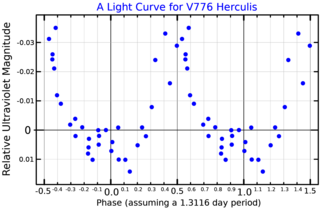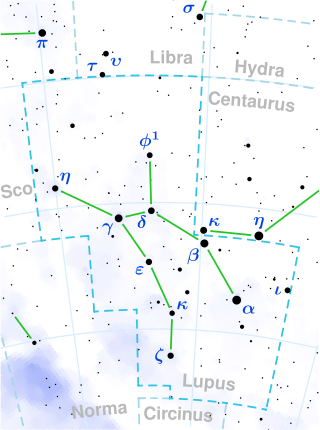Related Research Articles
Chi Scorpii, Latinized from χ Scorpii, is a single star in the zodiac constellation of Scorpius. It has an orange hue and can be faintly seen with the naked eye with an apparent visual magnitude of 5.24. Based upon parallax measurements, this star is around 448 light years from the Sun. The star is drifting closer with a radial velocity of −23.6 km/s.
Epsilon Sextantis, Latinized from ε Sextantis, is a solitary, yellow-white hued star in the equatorial constellation of Sextans. With an apparent visual magnitude of 5.24, it is faintly visible to the naked eye on a dark night. The distance to this star, based upon an annual parallax shift of 16.86 mas, is about 193 light years. It is drifting further away from the Sun with a radial velocity of +15 km/s.
21 Aquarii is a single star in the zodiac constellation of Aquarius. 21 Aquarii is the Flamsteed designation. It is visible to the naked eye as a dim, orange-hued star with an apparent visual magnitude of 5.49. This object is a member of the HR 1614 moving group, and is moving closer to the Earth with a heliocentric radial velocity of −24.5 km/s.
Lambda Caeli, Latinized from λ Caeli, is a star in the constellation Caelum. It is also known by its designations HD 30202 and HR 1518. This star is a challenge to view with the naked eye, having an apparent visual magnitude of 6.24. Based on parallax measurements, Lambda Caeli is known to be around 700 light-years distant from the Sun, but is drifting closer with a radial velocity of −4 km/s.
HD 222093 is a double star in the equatorial constellation of Aquarius. It has an orange hue and is visible to the naked eye with an apparent visual magnitude of 5.68. The system is located at a distance of approximately 293 light years from the Sun based on parallax, but is drifting closer with a radial velocity of −13 km/s.

45 Herculis is a solitary variable star in the northern constellation Hercules. It has the Bayer designation l Herculis and the variable star designation V776 Herculis. The Flamsteed designation for this star comes from the publication Historia Coelestis Britannica by John Flamsteed. It is the 45th star in Flamsteed list of stars in the constellation Hercules, and is visible to the naked eye with a baseline apparent visual magnitude of 5.22. Parallax measurements show this star to be about 400 light-years away from the Solar System. It is moving closer to the Earth with a heliocentric radial velocity of −16 km/s.
56 Ceti is a single star located in the equatorial constellation of Cetus. Not found in the original Bayer catalogue, it was given the Bayer-like designation Upsilon1 Ceti by Flamsteed to distinguish it from Bayer's Upsilon Ceti, which Flamsteed designated Upsilon2 or 59 Ceti. In 1801, J. E. Bode included this designation in his Uranographia, but the superscripted designations Upsilon1 and Upsilon2 are not in general use today. 56 Ceti is the Flamsteed designation for this star.

ι Chamaeleontis, Latinized as Iota Chamaeleontis, is a single star in the southern circumpolar constellation of Chamaeleon. It is visible to the naked eye as a dim, yellow-white hued point of light, having an apparent magnitude of about 5.3. Based upon parallax measurements, this star is around 188 light years away from the Sun, but it is drifting closer with a radial velocity of −4 km/s.

Epsilon Crateris is a solitary star in the southern constellation of Crater. Visible to the naked eye, it has an apparent visual magnitude of 4.84. It is located in the sky above Beta Crateris, and slightly to the left, or east, marking the lower right edge of the rim of the bowl and is somewhat closer to Theta Crateris, which is further east at the top of the bowl. With an annual parallax shift of 8.67 mas as seen from the Earth, its estimated distance is around 376 light years from the Sun.

54 Eridani is a suspected astrometric binary star system located around 400 light years from the Sun in the equatorial constellation of Eridanus. It is visible to the naked eye as a faint, reddish hued star with a baseline apparent visual magnitude of 4.32. The object is moving closer to the Earth with a heliocentric radial velocity of −33 km/s.
60 Herculis is a single star located 134 light years away from the Sun in the northern constellation of Hercules, and is positioned just seven degrees away from Rasalgethi. It is visible to the naked eye as a faint, white-hued star with an apparent visual magnitude of 4.871. This star is moving closer to the Earth with a heliocentric radial velocity of −4 km/s.
26 Hydrae is a binary star system located 334 light years away from the Sun in the equatorial constellation of Hydra. It is visible to the naked eye as a faint, yellow-hued point of light with a combined apparent visual magnitude of 4.77, just a few degrees away from Alphard. The system is moving closer to the Earth with a leisurely radial velocity of -1 km/s.
6 Hydrae is a single star in the equatorial constellation of Hydra, located 373 light-years away from the Sun. It has the Bayer designation a Hydrae; 6 Hydrae is the Flamsteed designation. This object is visible to the naked eye as a faint, orange-hued star with an apparent visual magnitude of 4.98. It is moving closer to the Earth with a heliocentric radial velocity of −8 km/s. Eggen (1995) listed it as a proper motion candidate for membership in the IC 2391 supercluster.

Phi1 Lupi is a solitary star in the southern constellation of Lupus. It is visible to the naked eye with an apparent visual magnitude of 3.58. Based upon an annual parallax shift of 11.86 mas as seen from Earth, it is located around 275 light years from the Sun. The star is drifting closer with a radial velocity of −29 km/s. It has an absolute magnitude of −1.55.
1 Lupi is a solitary giant star in the southern constellation of Lupus. It has the Bayer designation i Lupi; 1 Lupi is the Flamsteed designation. The apparent visual magnitude is 4.90, which indicates it is faintly visible to the naked eye. Based on parallax measurements, this star is approximately 1,800 light-years from the Sun. It is moving closer to the Earth with a heliocentric radial velocity of −23 km/s.
Mu Muscae, Latinized from μ Muscae, is a solitary star in the southern constellation of Musca. It is visible to the naked eye as a faint, orange-hued star with an apparent visual magnitude of around 4.75. Based upon an annual parallax shift of 7.21 mas as seen from Earth, it is located about 450 light years from the Sun. The star is drifting further away with a radial velocity of +37 km/s.
89 Virginis is a single star in the zodiac constellation of Virgo, located 234 light years from the Sun. It is visible to the naked eye as a dim, orange-hued star with an apparent visual magnitude of 4.959. The star is moving closer to the Earth with a heliocentric radial velocity of −39 km/s.
77 Ceti is a single, orange-hued star located 489 light years away in the equatorial constellation of Cetus. It is faintly visible to the naked eye, having an apparent visual magnitude of 5.7. This is an evolved giant star with a stellar classification of K2 III. It is radiating 187 times the Sun's luminosity from its photosphere at an effective temperature of 4,206 K.
HR 4699 is a single star in the southern constellation of Corvus. It is orange in hue and is dimly visible to the naked eye with an apparent visual magnitude of +5.14. This star is located at a distance of approximately 201 light years from the Sun based on parallax. It is drifting further away with a radial velocity of +14 km/s, after come to within 45.1 light-years some four million years ago.
HD 46815 is a solitary star in the southern constellation Columba. It is faintly visible to the naked eye with an apparent magnitude of 5.4 and is estimated to be 408 light years away. However, it is receding with a heliocentric radial velocity of 32.2 km/s.
References
- 1 2 3 4 5 6 7 8 9 10 11 12 13 Brown, A. G. A.; et al. (Gaia collaboration) (August 2018). "Gaia Data Release 2: Summary of the contents and survey properties". Astronomy & Astrophysics . 616. A1. arXiv: 1804.09365 . Bibcode: 2018A&A...616A...1G . doi: 10.1051/0004-6361/201833051 . Gaia DR2 record for this source at VizieR.
- 1 2 3 4 Anderson, E.; Francis, Ch. (2012). "XHIP: An extended hipparcos compilation". Astronomy Letters. 38 (5): 331. arXiv: 1108.4971 . Bibcode:2012AstL...38..331A. doi:10.1134/S1063773712050015. S2CID 119257644.
- 1 2 Houk, N.; Swift, C. (1999). "Michigan catalogue of two-dimensional spectral types for the HD Stars". Michigan Spectral Survey. 5. Bibcode:1999MSS...C05....0H.
- ↑ Mermilliod, J.-C. (1986). "Compilation of Eggen's UBV data, transformed to UBV (unpublished)". Catalogue of Eggen's UBV Data. Bibcode:1986EgUBV........0M.
- 1 2 McWilliam, Andrew (December 1990). "High-resolution spectroscopic survey of 671 GK giants. I - Stellar atmosphere parameters and abundances". Astrophysical Journal Supplement Series. 74: 1075–1128. Bibcode:1990ApJS...74.1075M. doi: 10.1086/191527 .
- ↑ "45 Eri". SIMBAD . Centre de données astronomiques de Strasbourg . Retrieved 2019-05-28.
- ↑ Eggleton, P. P.; Tokovinin, A. A. (September 2008). "A catalogue of multiplicity among bright stellar systems". Monthly Notices of the Royal Astronomical Society . 389 (2): 869–879. arXiv: 0806.2878 . Bibcode:2008MNRAS.389..869E. doi: 10.1111/j.1365-2966.2008.13596.x . S2CID 14878976.